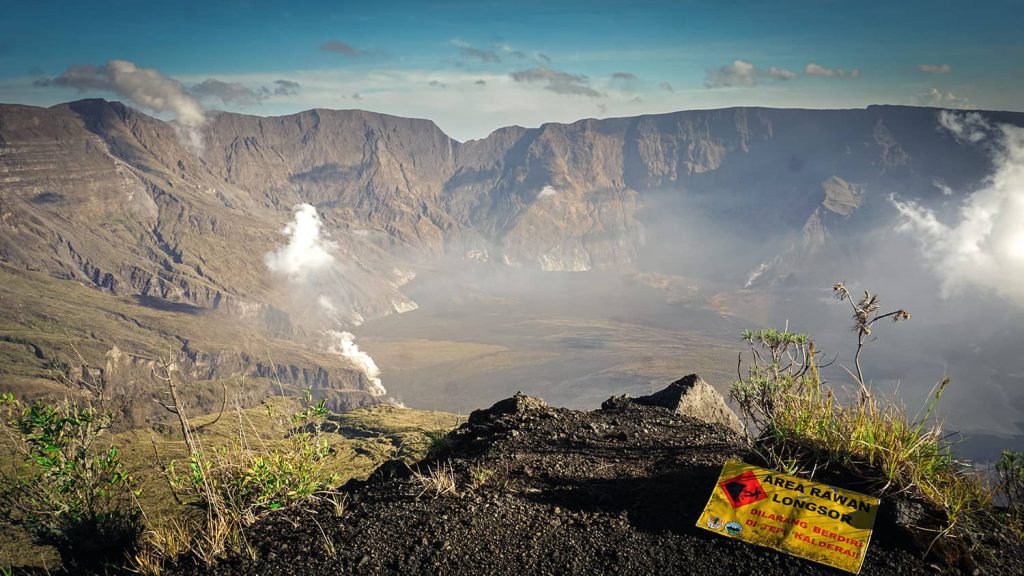Contents
A Brief Introduction to Mount Tambora
Mount Tambora is known for having the most powerful volcanic eruption in modern history. The eruption in 1815 created a massive caldera with a diameter of 7 kilometers. Standing at the summit and gazing into the caldera is a humbling reminder of this incredible event that occurred over two centuries ago.
Today, Mount Tambora offers three official trekking routes: the Pancasila Route (for trekking only), the Piong Route, and the Doro Ncanga Route. This article will focus on the Doro Ncanga Route, which allows access by 4WD vehicles and trail motorbikes.
How to Get to Mount Tambora

Mount Tambora is located on Sumbawa Island, West Nusa Tenggara, east of Lombok Island. Traveling overland from Lombok takes approximately 12 hours to reach Mount Tambora National Park.
For those flying, you can choose between Bima Airport or Sumbawa Airport. Both airports accommodate small ATR aircraft. From Bima Airport, it’s a 4-hour drive to Tambora via Doro Ncanga. From Sumbawa Airport, the drive takes about 5 hours.
Getting to Doro Ncanga

Doro Ncanga is an expansive savanna within Mount Tambora National Park. The route through Doro Ncanga is typically traversed using 4WD vehicles or trail motorbikes, as most of the path is open savanna with minimal shade. Walking this route is rare due to the intense heat under the direct sun.
Access from Bima Airport
After arriving at Bima Airport, you can continue to Doro Ncanga by public transport. However, public transport is limited and not always available. If you’re lucky, you may find a direct bus to Doro Ncanga. Alternatively, take a bus to Dompu, then proceed to Manggalewa (Cabang Banggo), where you can find another bus heading to Doro Ncanga or Pancasila Village.
If renting a 4WD from Bima, it’s advisable to travel with a group to share the cost, as rentals can be expensive.
Access from Sumbawa Airport
From Sumbawa Airport, take public transport to a local gas station known as “Pom Bensin Atas” in town. From there, board a bus to Dompu/Cabang Banggo. Once at Cabang Banggo, look for another bus heading to Doro Ncanga.
Suggested Arrival Time

To maximize your time, aim to arrive at Bima or Sumbawa airports in the morning. This allows you to head straight to the national park and spend the night around Doro Ncanga or Cabang Banggo before starting your hike the next day.
Preparation Before the Hike
If you plan to hike on foot from Doro Ncanga, consider camping near the Mount Tambora National Park office, as there are no homestays in the area. If using a 4WD vehicle, you can stay overnight at Cabang Banggo and have the vehicle pick you up the next morning.

Mount Tambora Trekking Package Via Doro Ncanga
Start IDR 3.520.000 per person
Trekking Route from Doro Ncanga
The hike through Doro Ncanga is divided into three checkpoints:
- Checkpoint 1: Near the National Park office.
- Checkpoint 2: Approximately 2 hours from Checkpoint 1 by 4WD.
- Checkpoint 3: Another 2 hours from Checkpoint 2 by 4WD.
For those walking, it may take an entire day to reach Checkpoint 3. You can set up camp here and rest before heading to the summit.
The final ascent to the summit takes about 2 hours on foot. Starting the “summit attack” at 4 a.m. is recommended to catch the sunrise over Mount Tambora’s caldera.

Additional Tips for Trekking Mount Tambora
- Physical Training: A week before your hike, do daily exercises like jogging for 30 minutes to boost your stamina.
- Plan Transport Carefully: Public transportation options are limited. Make sure you have backup plans for a smoother journey.
- Bring Enough Water: There are no water sources along the Doro Ncanga route, so bring enough for two days.
- Best Time for the Summit: Begin your ascent at 4 a.m. for the best sunrise views and photo opportunities before the fog sets in.
Conclusion
Trekking Mount Tambora via the Doro Ncanga route offers a unique experience through vast savannas, challenging adventures, and a deep connection to history and nature. With proper preparation, you’ll enjoy an unforgettable journey to one of Indonesia’s most iconic and historic mountains.








